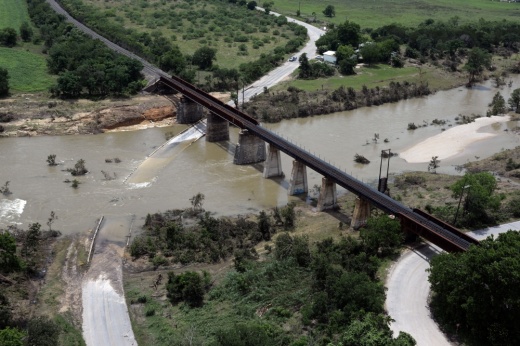A decade after two historic Hays County floods, memories are vivid as recovery continues.
Mark Gleason, a Blanco Gardens resident and former San Marcos council member, recalls standing outside his home during the first flood as waters receded, surrounded by eerie silence. There was no highway noise, no electricity, no neighbors—only the sound of rushing water.
“The roar of the river and that was it... I’ll never forget the roar of the river,” Gleason said. “You could almost feel it under your feet. It was so powerful.”
Virginia Parker, then Martindale resident and now executive director of the San Marcos River Foundation, remembers that same haunting sound from her own experience of the flood.
"Just such an overwhelming sight to see the river that full and raging—it’s a sound that unless you’ve heard it, you can’t picture it,” Parker said.
What happened
The Memorial Day flood struck on May 23-24, 2015, causing the Blanco River to rise rapidly and overflow into the surrounding areas, according to the National Weather Service. Wimberley and San Marcos were among the hardest hit, suffering catastrophic property damage and 11 deaths.
Saturated ground turned stormwater into dangerous runoff. In Wimberley, the Blanco River surged from around 9 feet to 40 feet overnight, rising 5 feet every 15 minutes. In San Marcos, it crested at 43.08 feet, after being below 15 feet just hours earlier.
The community began recovery as the county was declared a federal disaster area. Less than six months later, the All Saints flood hit. Thanks to improved efforts, no lives were lost, according to San Marcos' city website. Still, the flood destroyed much of the progress made.
“It was devastating,” said Kharley Smith, former Hays County’ emergency management coordinator. “Disaster survivors had done so much work ... only to face destruction again.”
Many families, like Gleason’s, had just returned home after months of repairs.
“It was a kick in the teeth,” Gleason said.
Next steps
Flood debris destroyed homes, blocked drains and uprooted trees. Emergency services were overwhelmed, prompting National Guard deployment and helicopter rescues. Relief groups like the Red Cross and Samaritan’s Purse assisted, with shelters set up in churches, schools and community centers, according to current San Marcos mayor Jane Hughson, then a council member.
In response, the Blanco River Regional Recovery Team, or BR3T, formed to support long-term recovery. It now serves four counties, helping residents rebuild and access resources, President Earl Bolls said.
Hays County has since upgraded emergency infrastructure and now uses the federal Integrated Public Alert and Warning System alert system, Emergency Services Director Mike Jones said.
The county installed 30 flood monitors, with plans for more, as well as implementing Perry Weather systems for improved early warnings.
Managing the impact
Following the two devastating floods, San Marcos received $33.79 million in federal CDBG–Disaster Recovery, or CDBG-DR, funding in 2016 and $24.01 million in CDBG–Mitigation, or CDBG-MIT, funding in 2019.
CDBG-DR funds addressed housing needs, including 14 new homes for low- to moderate-income families, and supported additional mitigation projects. CDBG-MIT funds funded flood prevention measures, including green space purchases, flood warning tools like river gauges and barricades, and various plans and studies.
The bulk of funding supported four major stormwater infrastructure projects, according to city documents:
- Uhland Road improvements ($6.6M): Road reconstruction and new drainage to Blanco River; ribbon-cutting Sept. 2023
- Midtown drainage improvements ($3.2m): Intersection upgrades, ditch clearing, detention ponds; completed April 2024
- Blanco riverine flood mitigation project ($20.8m): Berms, floodwalls, and relief channel added; completed Aug. 2024
- Blanco Gardens drainage improvements project ($15.2m): Storm sewers and concrete channels installed; ribbon-cutting Jan. 2025
As of now, about $4.5 million in CDBG-MIT funding remains, which must be spent by 2031. The city will allocate these funds to future improvements once the Stormwater Master Plan is completed in 2026.
The city will continue updating its stormwater master plan, which includes updating flood and drainage models, identifying problem areas, developing a plan for future improvements, and more.
“We’re in a better position ... but we’re not done,” said Shaun Condor, San Marcos city engineering director.
What residents should know
Despite widespread aid, recovery from the 2015 floods was slow and complex. Many residents struggled to access Federal Emergency Management Agency assistance due to missing homeownership documents, Hughson said.
Debris removal, volunteer coordination and aid distribution took months—sometimes years.
Today, officials urge residents to plan ahead: create a two-week shelter-in-place kit and a three-day evacuation kit, and safely store vital documents. Gleason also recommends photographing belongings for insurance claims, preparing go bags and keeping pet carriers ready.
“We just have to be ready,” Hughson said.
Going forward
The 2015 floods prompted action in Hays County and across Texas, leading to the development of the state’s first flood plan. In 2019, voters approved Proposition 8, establishing the Flood Infrastructure Fund to support statewide mitigation projects.
Still, Gleason advocates for long-term solutions like building a flood-control reservoir—similar to Canyon Lake on the Guadalupe River. He calls on lawmakers to act, warning: “This is a reality that will happen again, I want people to remember—people lost their lives.”





